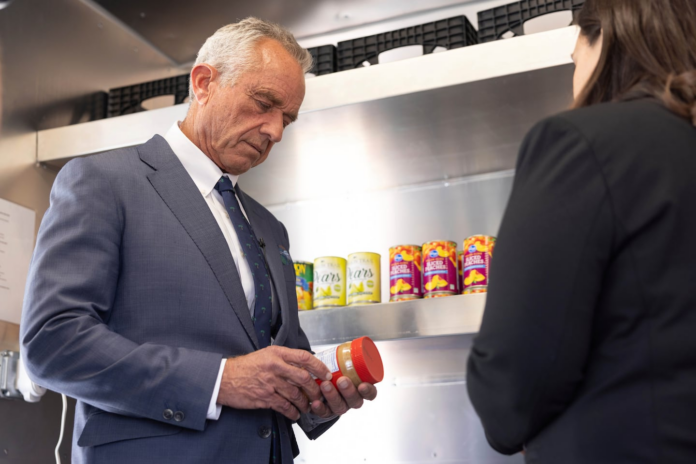Kennedy is crisscrossing the country amid an effort to ban unhealthy foods from the Supplemental Nutrition Assistance Program (SNAP). His primary target is soda, which he dubs “poison,” but US lawmakers answering his call are also seeking to bar sugary sweets and other foods deemed unhealthy. MAHA supporters say it’s a way to tackle the obesity crisis in America.
But just what that means has been a subject of fierce debate for decades. Lawmakers have fought over who should be eligible, how much they should get, and what they should be required to do to keep their benefits. Now, under the banner of Health Secretary Robert F. Kennedy Jr.’s “Make America Healthy Again” movement, there’s a spotlight on a different question: what food stamp recipients should be allowed to buy.
WASHINGTON — Since its first inception during the Great Depression, the food stamp program has had a simple enough goal: to help low-income Americans access suitable food.
Get Starting Point A guide through the most important stories of the morning, delivered Monday through Friday. Enter Email Sign Up
But those who use and defend the current SNAP structure say the issue is more complex than portrayed by MAHA and fear Kennedy’s push is a rebranded effort to cut SNAP, which serves nearly 42 million Americans and has a more than $110 billion yearly budget. Paired with other moves by the administration to end programs that helped low-income Americans access fresh produce, they question the government’s core commitment to improving American diets.
Advertisement
“There are so many other ways they could try to ‘make America healthy again,‘” said Janin Otero, 46, a SNAP recipient who works part time as a food service worker and works with Project Bread, a local antihunger nonprofit. She supports promoting healthy eating, but with high food prices, families’ practical needs, and the limited SNAP benefit, she worries further restrictions would only make life harder for those on the program.
Advertisement
“I want to believe that there are good intentions behind it, but … there’s a punishing effect to it,” she said. “It’s just way too nuanced to just be like, yeah let’s just make everything healthy.”
The concept is not exclusive to MAHA. An effort by officials in New York state to restrict “sugar-sweetened beverages” from SNAP benefits was rejected in 2011 as being unworkable. More recently, Iowa lawmakers rejected an effort to exclude such items as white bread, sliced American cheese, and fresh meat from SNAP. The debate has also surfaced in previous fights in Congress over farm bills. Even a bipartisan proposal to study SNAP purchases (data collection does not currently exist) set off controversy.
The most recent changes proposed by Republicans in the House and Senate, the Healthy SNAP Act, would ban soft drinks, candy, and desserts from SNAP, as well as order a study of further regulations to “promote the health of the population.”
In the meantime, Kennedy is urging states to request federal waivers to restrict soda and more from SNAP purchases, and has been visiting states already moving to do so, including West Virginia, Utah, and Arizona.
“Every American who wants to eat a doughnut ought to be able to eat it, or drink a Coke, but the federal taxpayers should not be paying to poison our children,” Kennedy told reporters at a recent press conference. “We’re going to end that.”
Advertisement
Calley Means, a health care entrepreneur and Kennedy adviser, argued reorienting SNAP will solve for many of ills of the food industry, including lowering the cost of healthy food and increasing grocery store access. SNAP accounts for about 10 percent of US food and beverage sales, according to the Wall Street Journal.
“The SNAP program … causes massive distortions in overall food prices,” Means said. “When you have a $120 billion program and the majority of that program through lobbying in the food industry goes to ultra-processed food and sugary food … that is a subsidy for that food and creates food deserts.”
Means said the arguments against banning soda from SNAP originate from soda lobbyists, and that antihunger groups are just a front for the food industry (some, but not all, antihunger groups do receive funding from the food industry).
“Anyone who suggests that the government should fund soda is deliberately or un-deliberately engaged in evil, because our kids have a metabolic health crisis,” Means said.
But SNAP beneficiaries and antihunger advocates argue that healthy food is pricier and harder to prepare for low-income families who face other obstacles, such inadequate transportation and access to grocery stores.
And even just banning certain beverages such as soda, they say, could cause difficulties for retailers and users to navigate: It could potentially lead to to lower participation in the program by both, as well as result in the policing of eating habits of low income people more than other Americans, without increasing their resources for healthier options.
The average household SNAP benefit is $239 per month, roughly $2.50 per meal. It is a challenge to feed a family or an elderly or disabled recipient without using processed foods, SNAP users said, on top of other challenges, such as not having adequate cooking facilities or even safe tap water. Little data exists on the question, but a 2016 analysis by the Department of Agriculture found “no major differences” between food buying habits of SNAP recipients and the general public, including sugar consumption.
Advertisement
“The reality is it is more expensive to be able to follow a healthy diet in this country,” said US Representative Jim McGovern of Worcester, a longtime antihunger advocate. “We should do everything we can to encourage people to move in that direction, but to not acknowledge that resources play a role in this is just ridiculous.”
Carolyn Barnes, a University of Chicago researcher who interviews SNAP recipients, called the MAHA push an “elite-driven, in some ways a paternalistic discussion.”
“We’re policing what low-income moms feed their kids with the assumption that they don’t know,” Barnes said. “People [in poverty] buy food the way that everyone else does, they just ration.”
Barnes’ said her research has shown that when SNAP recipients receive large benefits, they buy healthier food. And when programs are more complicated to navigate, she said, participation tends to plummet.
Those who use SNAP in Massachusetts agree. Alexandra Mello, 49, a mom from Northampton who works with Project Bread and uses SNAP, said she remembers the difficulty of using the more-restrictive Women, Infant, and Children (WIC) program benefits when her children were young.
“It would cause more stigma, more stress for people to be able to already on a budget try to go and navigate the grocery store, and that’s if the stores even stock the products their family would eat,” Mello said.
Advertisement
Massachusetts pioneered the Healthy Incentives Program (HIP), which gives SNAP users more money for buying produce from local farmers. The program has been so popular that it’s become too expensive for the state to fully fund, and was recently cut back in the state budget.
Despite Kennedy’s focus on healthy food, the Trump administration has cut other programs that expanded access to fresh produce, including for schools, food banks, and child care centers. Those have hit Massachusetts farmers and communities hard.
Meg Bantle, 32, runs an organic produce and flower farm in Adams and is also a SNAP recipient. Bantle’s business has boomed with the Masachusetts healthy foods program, which has helped it sell CSAs and produce at farmers markets to SNAP users.
“They never turn down the opportunity to fill their basket with that much money worth of food,” Bantle said of shoppers finding out about their HIP benefits.
With the recent cuts to the Massachusetts and federal low-income produce programs, Bantle fears what’s ahead for their business and the impacts to people reliant on the program.
“We are on the front lines of seeing how these cuts affect people in our community,” Bantle said. “I get emotional thinking about these programs getting cut, because … it’s not state legislators and it’s not people in MAHA who have to turn people away who are trying to buy food for their household — it’s me.”
Tal Kopan can be reached at tal.kopan@globe.com. Follow her @talkopan.




